The second most expensive spice in the world after saffron, vanilla is a consumer favorite. But it is also a very complex and fragile industry. In Madagascar, where most of the global supply comes from, rural poverty is reaching up to 81% [1]. In the past few decades, the sector has faced strong speculation, lack of transparency and high exposure to weather events which have kept vanilla smallholders in a poverty trap. Back in 2017, Livelihoods launched an ambitious project in the north-east of Madagascar to build a resilient supply chain with 3,000 family farms, over 10 years.
But five years later, has this new supply chain improved the farmers’ position in the sector? Have they managed to improve their income? Have they managed to produce high-quality vanilla while preserving their natural ecosystem? Livelihoods is publishing the encouraging results of a social audit in the area. Conducted end of 2021 by INSUCO, an independent international consulting firm specialized in social sciences, the audit demonstrates that the transition towards a resilient and high-quality vanilla is certainly underway.
Livelihoods' vanilla project in a nutshell:
An innovative investment model
L3F has brought together a coalition of private and public actors to tackle some of the economic challenges deeply rooted in the vanilla sector. The fund bears the investment risk and pre-finances the project activities to structure the supply chain. Danone, Firmenich and Mars (through its supplier Prova) have committed to purchase the vanilla produced by the farmers at a fair price for 10 years. The activities are implemented on the ground by Fanamby, a Madagascan NGO with extensive experience working with vanilla producers, Missouri Botanical Garden, a biodiversity conservation NGO and Maisons Familiales Rurales, an educational association.
The project economic activities are co-financed by the French Development Agency (AFD), a public institution which works to combat poverty and promote sustainable development in all continents. The French Facility for Global Environment (FFEM) is also involved to support biodiversity preservation in Pointe à Larrée. This facility implements sustainable development projects that integrate the preservation of public goods, international solidarity, and innovation in developing and emerging countries.
A sustainable, quality supply chain with 3,000 family farmers
The project is setting up a new supply chain which provides the farmers with the skills, infrastructure and material to produce high quality vanilla and improve their revenues. During the first five years of the project, farmers were trained on sustainable practices to increase vanilla productivity and quality. The creation of a farmer-owned cooperative aims to connect the farmers directly to the market and better integrating women and the youth in the vanilla production. In a context of high price fluctuations, the project is focusing on theft control, speculation avoidance and green vanilla prices to achieve prices standardization and more stable revenues for the farmers.
The project also seeks to protect 4,500 hectares within a unique tropical forest and a rich in biodiversity ecosystem: Pointe à Larrée. To achieve this, the partners are putting in place a community-based governance to manage conservation activities, apply biodiversity protection laws, and plant native tree species to prevent the area from natural disasters. Project activities include offering farmers alternative economic opportunities, such as clove production and poultry farming, to preserve local forests from illegal logging and slash-and-burn practices.
A social audit to give the word to the farmers
The respondents are all smallholder independent farmers located in the project area: the district of Soanierana-Ivongo (region of Analanjirofo) in the north-eastern part of the island, below Sava. It is spreading over more than 1,000 km2 and includes four municipalities [2]. The area is bordering a unique in biodiversity ecosystem: Pointe à Larrée, which is threatened due to increased pressure from local communities who seek for new sources of income.
Conducted in 2021, midway of this 10-year project, the survey aimed to capture the perception of the family farmers on 5 main topics: has the structuring of the new supply chain improved their position in the sector? Has the new organization helped to improve their income? Have they improved the quality of vanilla they produce? Has the project managed to better involve women and the youth in vanilla production? Is there less pressure on the local biodiversity?
This social perception audit was structured around three axes, mobilizing quantitative and qualitative questions to capture: the beneficiaries’ level of understanding about the project, their perception of the progress and results, and their perception of the pandemic’s possible impacts. The audit is based on a total of 109 farmer interviews, including 21 women. It was conducted among 91 households located in all 4 municipalities of the project area to represent a diversity of families. Facilitated by our local partner, Fanamby, the audit focused on capturing the functioning of 7 farmer organizations, by analyzing their governance, volumes of vanilla produced, and trainings provided. The study’s results are also based on the commercial transactions and governance audit conducted within Tambatra cooperative
1. 91% respondents consider the vanilla supply chain has improved significantly
Building a value-added industry for farmers was the first goal of the project. It aimed to shift to a transparent supply chain where farmers would be trained to produce high quality vanilla and earn a better income out of it. To date, the signals are very positive: 91% of respondents expressed that the structuring of the vanilla sector has significantly improved since the project launch, even during COVID pandemic. 95% of them shared that the vanilla industry has significantly improved as well. Plus, the theft rates of vanilla in their plots have been reduced from 60% to less than 5% in the area, thanks to solid support from legal authorities.
A vast majority of farmers (95%) expressed that the farmer organization “Tambatra” which was structured by the project partners, has significantly improved their working conditions in the sector. 82% of respondents also qualified the organization’s governance as good to very good. Tambatra, is a farmers-owned cooperative which provides the infrastructure, collection, delivery, and payment support to accompany farmers at every step of the production. To date, more than 2,000 family farms organized into 20 associations are involved in this farmer organization. The overall goal is to embark 3,000 families by the end of the project.
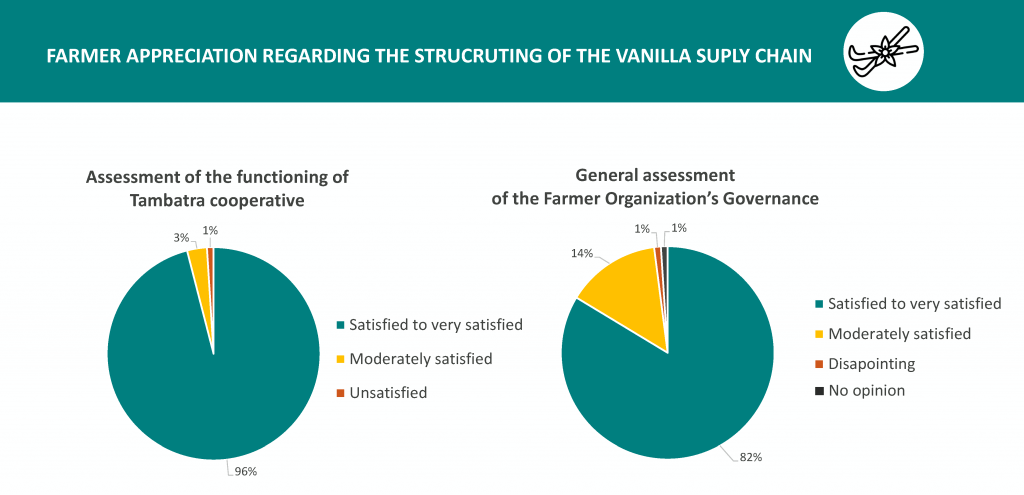
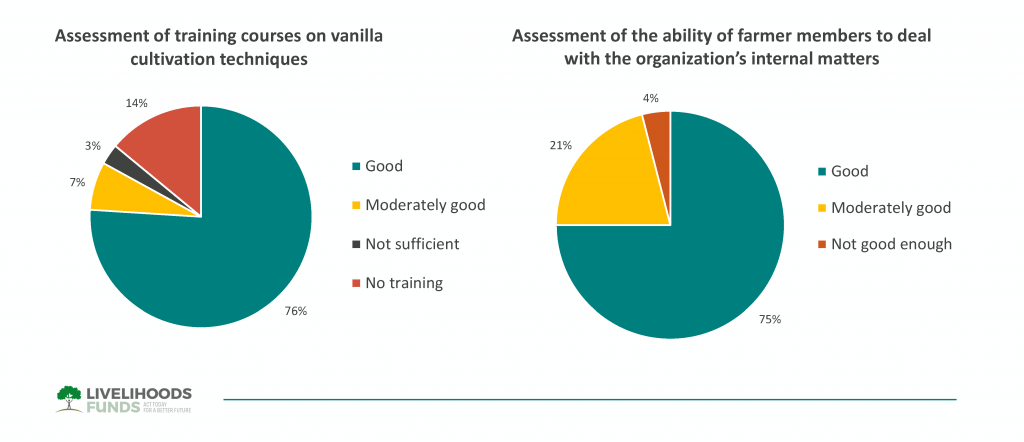
2. 96% of farmers consider that their vanilla income has improved significantly
Producing high-quality vanilla relies on high technical skills, patience, and precision. The farmers embarked in the project have been provided with technical trainings on vanilla production (from vines management, pollination to collection). Overall, 76% of farmers qualified the trainings received as good. 22% farmers even started to produce vanilla thanks to the project. When asked what contributed to improve their income, farmers mentioned the distribution of vanilla vines at the beginning of the campaign, an increasing price related to the higher quality of vanilla, direct sales made possible through the farmers organization with no intermediaries. This contributed to face the COVID crisis: 91% of them shared that household income remained stable during the pandemic.
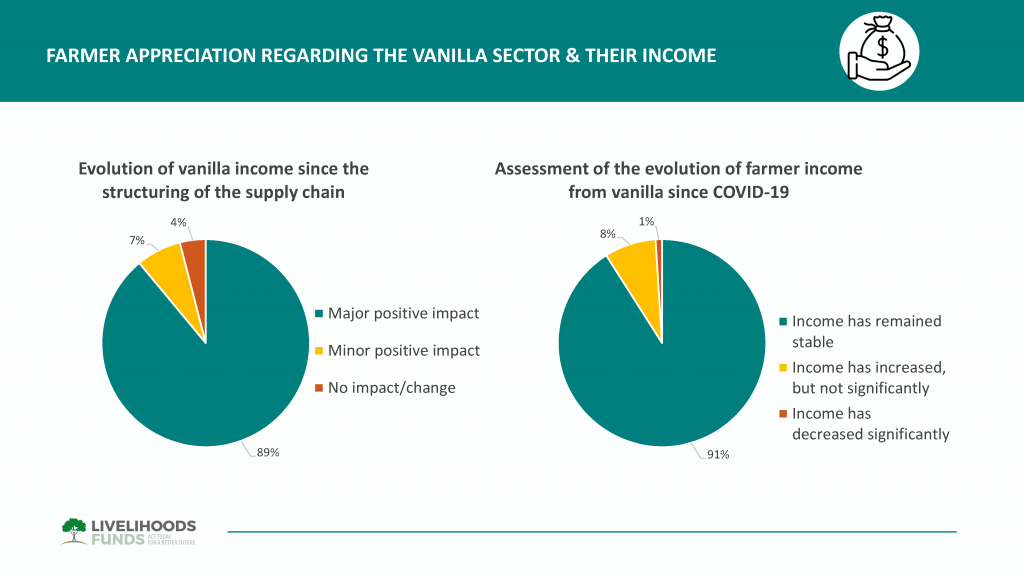
3. Women and young farmers are better involved in the supply chain
One important ambition of the project was to better embark women and young farmers in the industry. The project aimed to embark the youth in all vanilla-related activities and help them acquire land to perpetuate the skills and know-how to the new generations. 59% of respondents believe that the involvement of young people in the sector has improved significantly. Since the beginning of the project, access to employment for young people has improved significantly according to 63% of the producers interviewed. Plus, the project has allowed to open an agricultural school to train the youth. In December 2021, the school celebrated its first graduates.
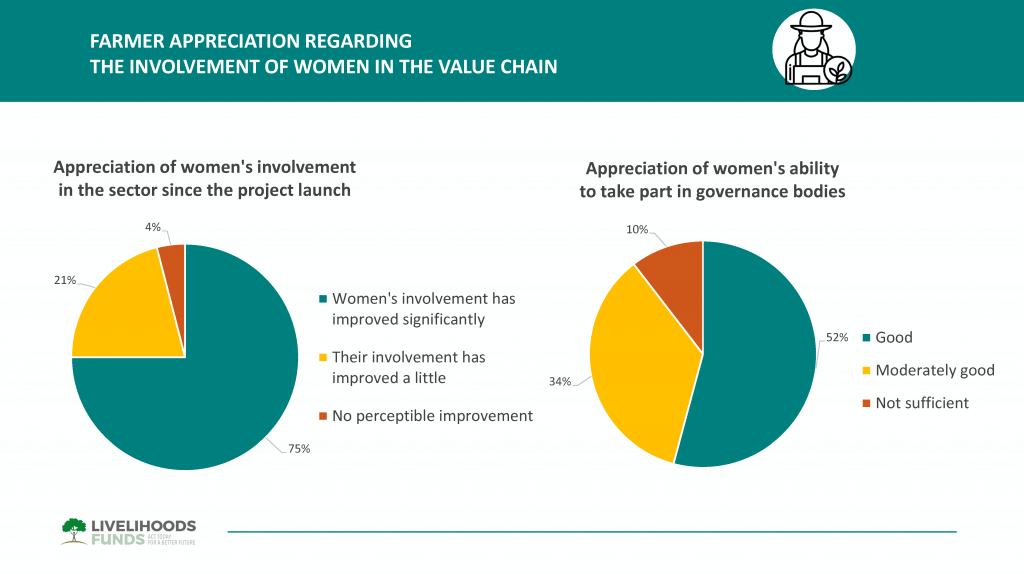
The ambition was also to help women be more involved in the chain and participate actively in the farmer associations. In other words, help them grow their entrepreneurial skills and make them active members of the transformation. Women have been supported both on production tasks (pollination, preparation of beans…) but also in decision making within the management of farmer associations. Today, 75% of respondents expressed women’s involvement has improved significantly and 30% of them shared the conditions of access to land for women have also highly improved. Plus, 52% of producers consider that the capacity of women to participate in the association’s governance bodies is good.
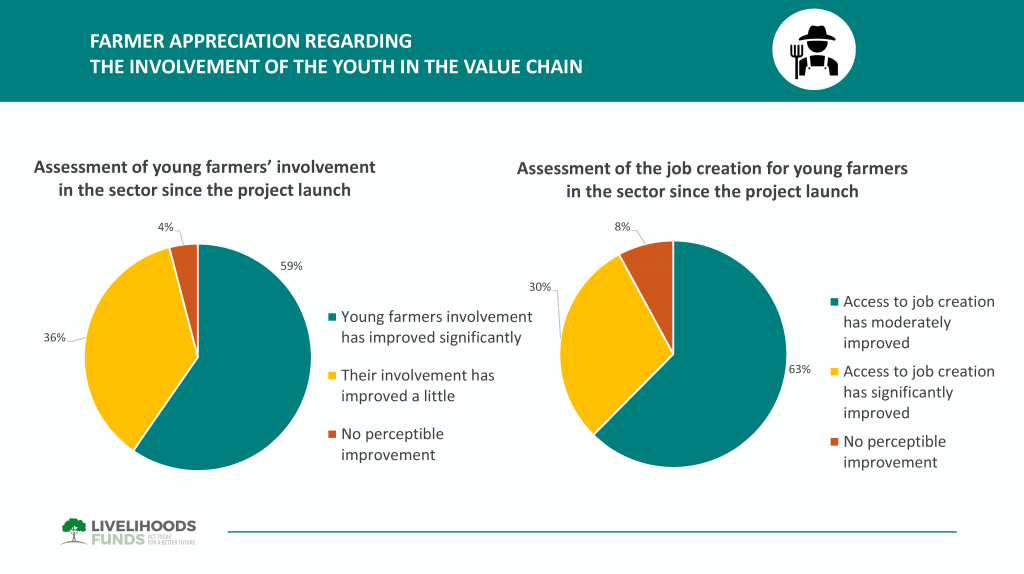
4. 770 hectares under biodiversity preservation achieved
Pointe à Larrée is anatural ecosystem located in the project area, declared by the Malagasi Government as a New Protected area in 2015. In the past few decades, it has increasingly been threatened by human pressure. Preserving 3,000 hectares of local biodiversity in the project area is one of the core goals of the initiative. Five years later, after a lot of awareness campaigns led by our local partners and the securing of farmer income thanks to a strengthened supply chain, communities have reduced the pressure on these natural resources. Today, the project has achieved to preserve 770 hectares. Overall, according to 88% of producers, the human activities that are threatening biodiversity have decreased significantly.
The study further showed that before the project, 15% of households were involved in charcoal burning, a figure which has now been reduced to 5%. The practice of tavy (slash & burn farming) has been reduced by almost half: from 20% to 13% since the beginning of the project.
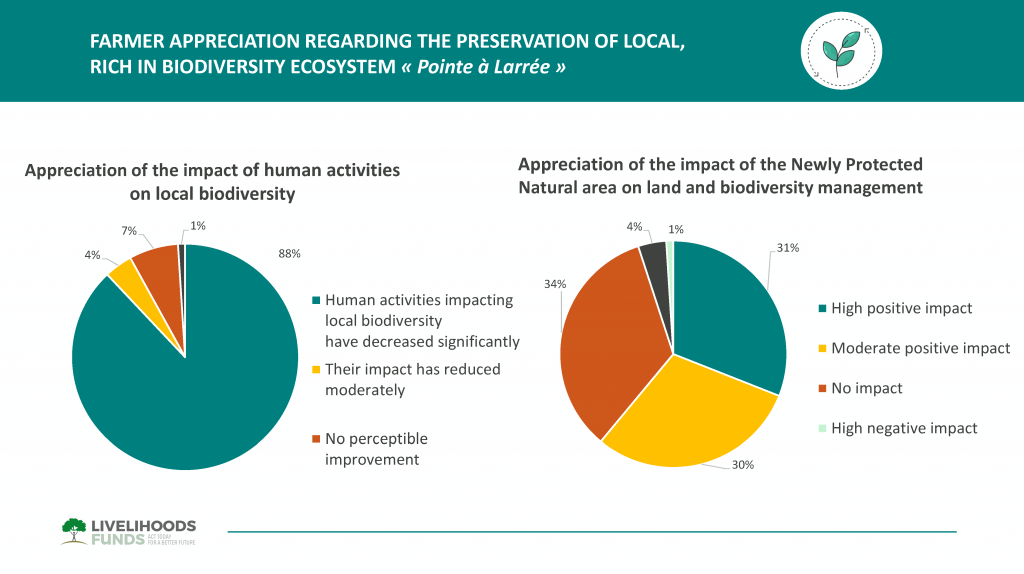
5. Leading towards more food security
If the transition is well underway regarding the structuring of a new, transparent supply chain, vanilla farmer income, the involvement of women and the youth and the preservation of local natural ecosystems, when it comes to food security and farm diversification, results are less clear-cut.
To date, the study shows that the local intervention has certainly brought an increase in cultivation practices (rice growing, market gardening), but to date, the increase is relatively small. While before the project the percentage of households practicing market gardening was 22%, the figure is now 24%. 86% of households were growing rice before the project versus 89% today. The trend is rather positive but shows one of the project’s challenges for upcoming years is to help farmers make an income outside of vanilla production to improve more significantly their food security. To date, 45% of producers feel that the lean season has improved moderately since the project began.
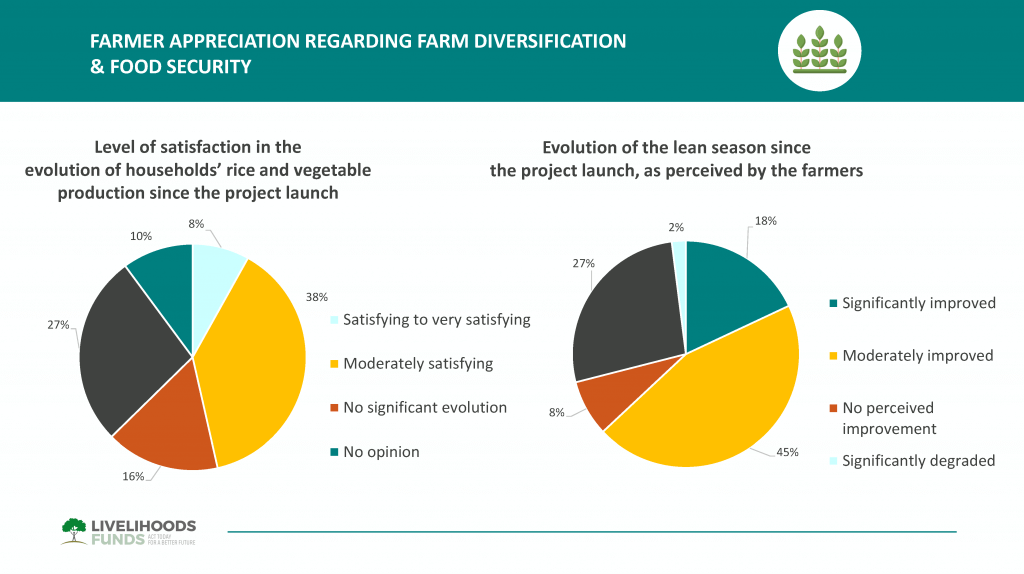
[1] December 2020, the World Bank announced Madagascar was recording it highest poverty level since 2012: 77.4%. In rural areas, this level of poverty was reaching 81%.
[2] The project area is divided into four municipalities, namely: Manompana, Antanifotsy, Ambodiampana and Fotsialanana.


